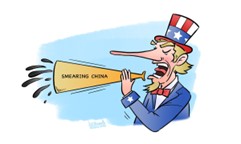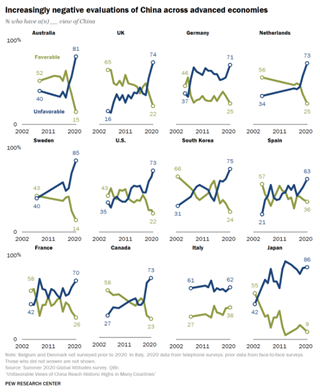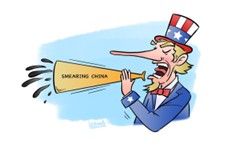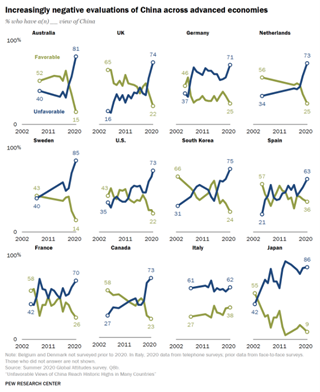Ella Wang:中国和美国都说对方在宣传战中获胜,双方谁对谁错?
除了互相抹杀对方的文化之外,中国和美国还有什么共同点?都试图让每个人都相信自己比对方更好。当然,在人权问题上,两国存在着巨大分歧——而且两国还就这一分歧发动了一场全球宣传战。
这些人权分歧根源于历史。西方个人主义、普世主义和自由主义人权观念的部分基本性质是,它们必须在全球范围内被采用,这些观念受到柏拉图、启蒙运动和革命时代的影响。另一方面,中华人民共和国 (PRC) 融合了儒家和共产主义的根源,强调的权利不那么具有全球影响力,不那么个人主义,而更注重社会经济。
尽管中国并不完全鼓励西方国家对人权的看法,但中国在批评西方国家(尤其是美国)人权方面却异常大声,并坚决压制任何可以审查中国侵犯人权行为的制度。中国的目标不是强制每个人享有以社会经济为重点的权利,而是确保其他人不能因为他们缺乏自由人权而追究他们的责任。
为了对抗西方关于普世人权的意识形态以及中国人认为缺乏这些权利的现象,中国的全球宣传表明,如果西方国家不遵守自己的国内规则,那么其对全球人权的宣扬就会失败。尤其是当针对美国人时,这种宣传既助长了人们对美国制度的怀疑,又试图让美国人同情中华人民共和国。为了改善其全球形象,中国似乎更注重数量而不是质量,他们花费了超过 100 亿美元进行软实力宣传,以说服其他人相信美国的承诺是空洞的,强调中国的伟大,并转移西方人对中国试图淡化自由主义侵犯人权行为的注意力。
中国庞大的资金支持着国家支持的新闻机构,例如专门针对英语受众的《环球时报》。这类在线平台最初似乎提供标准的新闻报道。然而,仔细观察就会发现,《环球时报》提供的是针对性的宣传,旨在批评美国并提出积极的中国叙事。
考虑一篇代表性文章“美国抹黑中国的古老策略”。文章声称美国政府对中国人民撒谎,特别是关于中国新疆地区有据可查的维吾尔族营地或中国议会的民主状况。文章通过操纵性的“煤气灯效应”——一种故意、系统地向受害者灌输虚假信息的操纵和心理控制手段——声称“任何读到这篇文章的美国人都会、也应该对这种罪行感到震惊,只是其中没有一个字被证明是真的。”
这类文章明显是针对英语世界的。例如,文章中的政治漫画与美国政治漫画相似,而且全部是英文的。然而,这些表面上西式的漫画并没有太多含义,只是字面意思。举个典型的例子:

图片没有留下任何疑问或误解的余地,甚至与美国标志性人物山姆大叔很像。他们的目标很简单:让美国人相信这些文章是美国人写的,或者至少是西方国家写的,以进一步让他们相信中国并没有那么糟糕。
美国搞的是另一种宣传。它更加隐蔽,不太可能进行煽动,而且不仅来自美国政府,也来自私人行为者,特别是私人媒体。此外,美国政府似乎直到最近才注意到中国宣传的威胁,并部署了反制措施。2024 年,众议院支持了一项法案,将在五年内花费 16 亿美元用于推动反华宣传。与中国政府每年在宣传上花费的 100 亿美元相比,这项法案所需的资金似乎微不足道。然而,重要的是要认识到,由于中国政府对中国媒体的控制,美国的宣传在中国基本上没有引起任何反响。这给了中国独特的优势,它能够用他们的宣传影响美国人,但不允许美国对其人民做同样的事情。
潜在的问题仍然存在:这种宣传有效吗?谁在这场宣传战中获胜?有人真的改变了对这两个国家的看法吗?一方面,随着对中国的负面看法达到历史最高水平,中国向西方和/或发达国家传递的信息似乎失败了。最近对 14 个发达国家的一项调查显示,公众对中国的看法从 21 世纪初的普遍正面转变为 2010 年代末的明显负面。

收视率的下降似乎与中国试图增加针对西方人的宣传有关。虽然不确定这是因果关系还是仅仅是巧合,但不可否认的是,西方新闻媒体的模仿者并没有起到多大作用;尽管在新冠疫情期间投入了巨额宣传资金并成功改变了媒体叙事,但收视率仍然很低。
这并不是说中国在疫情后没有成功地维持其积极的全球形象。尽管许多发达国家对中国的看法越来越负面,但非洲许多国家却开始以更积极的态度看待中国。非洲晴雨表(一家非营利、无党派的调查研究网络)的一项调查显示,16 个非洲国家中有 65% 的人认为中国的影响是积极的。但这不仅是因为大量的宣传,中国还在非洲投入了大量资金和政治资本。在过去 20 年里,中国已成为“撒哈拉以南非洲最大的双边贸易伙伴”。
虽然这看起来像是美国在非洲的影响力之战中“失败了”,但非洲晴雨表首席执行官约瑟夫·阿苏卡博士解释说,对中国影响力持积极态度的人也更有可能将美国的影响视为积极的。“每个国家的评级可能与每个国家的具体行动或投资关系不大……而是反映了对外部力量是否总体上有助于受访者所在国家的福祉的总体看法,”他说。这带来了一个新的视角,即美国和中国都可以改善其全球形象。双方不必确定胜负。
中国并不是唯一一个通过宣传改善其全球形象、对抗西方人权观念的国家。正如安妮·阿普尔鲍姆所表明的那样,中国与其他日益专制的国家(如俄罗斯)合作,在全球范围内“毒害”自由人权思想。非专制世界才刚刚开始反击这些运动。但问题仍然存在。专制世界试图传播其价值观和形象是一场零和游戏吗?或者,自相矛盾的是,专制和非专制世界的形象都可以得到改善,就像非洲可能展示的那样?
如果“自由世界”想要在“宣传战”中有效反击,而没有像中国那样获得巨额资金,那么它需要的不仅仅是用更加脱节的宣传进行反击,而是一个集体战略,让政策制定者了解“反美主义”在中国政治中的作用,考虑中国人对美国人的看法,避免刻板印象,并积极采取措施抵制中共信息的传播。
China and the US both say the other is winning the propaganda war. Is either right?
What do China and the US share, besides butchering each other's cultures? Trying to convince everyone that they're better than the other. Certainly, on the issue of human rights, they sharply differ -- and they have launched a global propaganda war over this discrepancy.
These discrepancies over human rights are rooted in history. Part of the fundamental nature of Western notions of individualistic, universalistic, and liberal human rights, drawing on influences from Plato to the Enlightenment and Age of Revolutions, is that they must be globally adopted. On the other hand, The People’s Republic of China (PRC), drawing on a mix of its Confucian and communist roots, emphasizes less globally reaching, less individualistic, and more socio-economic-focused rights.
Although China doesn’t precisely encourage their perspective on human rights, China has proved exceptionally loud in criticizing Western -- especially US-- human rights and steadfast in neutralizing any system that can scrutinize China's human rights’ violations. Its goal is not to enforce socio-economics-focused rights for everyone, but to ensure that others can not hold them accountable for their lack of liberal human rights.
To counter Western ideologies on universalistic human rights and the perceived lack of these rights among the Chinese people, China’s global propaganda suggests that the West’s preaching on global human rights falls flat when it doesn’t follow its own rules at home. Especially when targeted at Americans, this propaganda both fosters doubt in the American system and tries to get Americans to sympathize with the PRC. To try to improve its global image, China seems to be focused on quantity over quality, as they use upwards of 10 billion USD in soft power campaigns to convince others of the hollowness of U.S. promises, highlight China’s greatness, and distract Westerners from the liberal human rights abuses that China tries to de-emphasize.
China’s massive funding powers state-backed news outlets such as the Global Times, which specifically targets English-speaking audiences. Such online platforms initially appear to provide standard journalism. However, upon closer inspection, the Global Times delivers targeted propaganda aimed at critiquing the US and suggesting a positive Chinese narrative.
Consider one representative article, “The age-old tactics used by the US to smear China”. The article claims that the American Government has lied to its people about China, particularly concerning the well-documented Uygur camps in the Xinjiang region of China or the state of democracy in the Chinese parliament. Through manipulative gaslighting, a form of manipulation and psychological control where victims are deliberately and systematically fed false information, the article claimed that “Anyone in America reading this would, and should, be horrified by such crimes, except that not one word of it has been proven to be true.”
Such articles are clearly aimed towards the English-speaking world. For example, the political cartoons included are similar to US political comics, and all of it is in English. Yet these superficially Western-style cartoons don’t hold much meaning and are literal. Take this typical example:

The image leaves no doubt or room for misinterpretation, even resembling Uncle Sam, an iconic American character. Their goal is simple: getting Americans to believe that these are articles written by Americans, or at least from Western countries, in order to further convince them that China isn’t all that bad.
America engages in a different sort of propaganda. It is more discrete, less likely to gaslight, and comes not only from the American government, but also from private actors, especially private media. Furthermore, the U.S. government has only recently seemed to notice the threat of Chinese propaganda and deployed countermeasures.In 2024, the House of Representatives backed a bill that spends 1.6 billion USD within five years to promote anti-China propaganda. Compared to the 10 billion USD that the Chinese government spends annually on propaganda, the amount of money this bill requires seems miniscule. Yet, it is important to recognize that, due to the Chinese government’s control of Chinese media, American propaganda largely falls on deaf ears in China. This gives China the unique advantage of being able to affect Americans with their propaganda, but not allowing America to do the same to its people.
Underlying questions remain: has this propaganda been effective? Who is winning this propaganda war? Is anyone’s opinion of either country really being changed? On the one hand, China’s messaging to Western and/or developed countries seems to be failing, as negative views of China reach historic heights. A recent survey of 14 developed countries shows that public views of China went from generally positive in the early 2000s to distinctly negative by the late 2010s.

These dips in ratings seem to correlate with Chinese attempts at increasing propaganda aimed at Westerners. Although it isn’t certain if this is causation, or simply a coincidence, it is undeniable that the Western news outlet look-alikes didn’t do much to help; these poor ratings are despite huge propaganda investments and success in shifting the media narrative during Covid.
This is not to say that China has had no success in sustaining a positive global image of itself after the pandemic. Although many developed countries have increasingly negative views of China, many countries in Africa are starting to see China in a more positive light.One survey from Afrobarometer, a non-profit and nonpartisan survey research network that surveys Africans, determined that 65% of people across 16 African countries believe that China’s influence is positive. But this isn’t only because of the copious amounts of propaganda, China has invested significant funds and political capital in Africa. Over the last 20 years, it has become “sub-Saharan Africa’s biggest bilateral trading partner”.
Though this may seem like America has “lost” the influence battle in Africa, the CEO of Afrobarometer Dr. Joseph Asunka explains that people who feel positively about the influence of China are also more likely to also view U.S. influence as positive. “Ratings of each country may have less to do with the specific actions or investments of each … but instead reflect an overall sense of whether external powers are generally contributing to the well-being of the respondent’s country,” he says. This brings in a new perspective, that both the U.S. and China can improve their global image. Neither of them has to definitively win or lose.
China is not alone in its ongoing struggle to improve its global image and counter Western notions of human rights through propaganda. As demonstrated by Anne Applebaum, China collaborates with other increasingly authoritarian countries, like Russia, to “poison” the ideas of liberal human rights globally. The non-authoritarian world is just starting to counter these campaigns. But questions remain. Is the authoritarians' world attempt to propagate its values and image a zero-sum game? Or can, paradoxically, both the authoritarian and non-authoritarian world’s image improve, as possibly demonstrated in Africa?
If the “Free World” wants to effectively fight back in the “propaganda war”, without the massive funding China enjoys, it needs to not just fight back with more disjointed propaganda, but a collective strategy where policy makers understand the role “anti-Americanism” in Chinese politics, consider what the Chinese think of Americans, avoid the stereotypes, and actively take measures to counter the spread of the CCP’s messages.
2025 年 2 月 17 日上传
